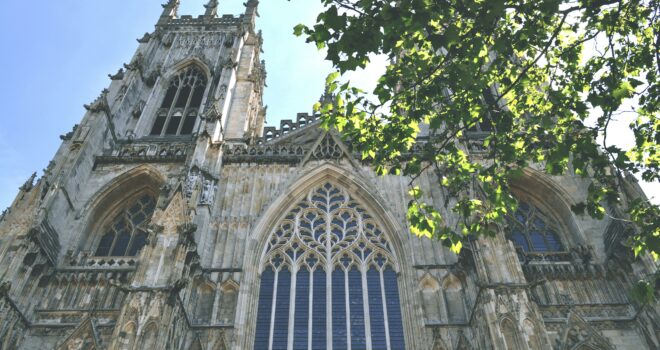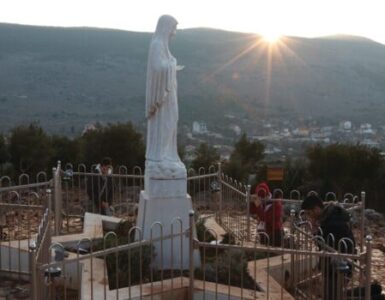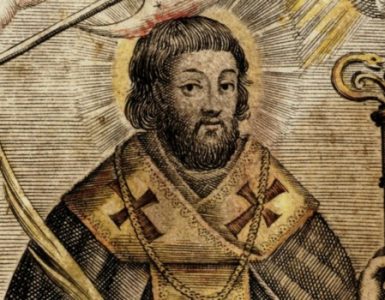This summer, I traveled to England for the first time, and in many ways I found it endearing. London’s taxis were black instead of yellow and the buses double-decker. Bacon was basically a thick slice of ham—and the breakfasts hearty and delicious (eggs, mushrooms, beans, boiled tomatoes, toast, and black tea or coffee). Plus, friendly cashiers would close off conversations with “Cheers” (to which I’m still not sure how to respond)!
I went to England with the focus of studying Shakespeare in his birthplace and visiting sites like Stonehenge—but I also had another objective in mind. I wanted to gauge the country’s religiosity, curious to find how it would differ from the States.
Though I knew England to be famously “not Catholic” (Henry VIII, Anglicanism, etc.), I was still surprised by the lack of Catholic Mass options. The United States aren’t Catholic the way other countries’ histories are, but still where I’m from you can find a Catholic church on every block, offering multiple Mass times throughout the week! In England, it’s not so easy. Upon learning this, I thought that I wouldn’t encounter much Catholicism for the rest of my trip.
Thankfully, I was I wrong! Everywhere I traveled, I discovered remnants of England’s Catholic roots. Even within the Church of England churches that I toured, I’d find priestly garments dating from the Middle Ages or pre-Reformation Catholic artwork that had been preserved. Even well-trodden tourist sites were often steeped in Catholic history.
Let’s take a closer look at a few places that give a sample of the Catholic influence still present in England…
Bath Abbey (Bath, Somerset)
Bath is one of the most beautiful cities I have ever visited. Built on rolling hills, it’s a city of graceful stone buildings, markets, cobblestone alleyways, and even its own mini-waterfall in the middle of the city! No wonder Bath is a UNESCO World Heritage Site.
I confess that my main goal was to experience the Jane Austen Centre museum (my life is complete now that I took a photo with Mr. Darcy!). Afterwards, I decided to step inside the enormous old church in the middle of a spacious square: Bath Abbey.
The interior of this Church of England place of worship is even more splendid than the outside. The church is known as the “lantern of the West” for its Lord of the Rings-style architecture that calls to mind a lantern! I learned that Bath Abbey is situated on the former location of a Catholic church before the Reformation.
So, not only did this church have history related to Catholicism, but it also called to mind the famous Catholic writer J.R.R. Tolkien. This wasn’t the only site I visited that reminded me of hobbits and elves, however…
St. Edward’s Church (Stow-on-the-Wold, Gloucestershire)
I’d never heard of the Cotswolds countryside area before my trip to England. On a day-long bus tour through some of its most famous towns, I ended up learning a lot. The Cotswolds is known for its stone houses, thatched cottages, fresh cheese, and ice cream. (You have to try the clotted-cream-and-strawberry flavor!) One of my favorite towns was Stow-on-the-Wold, where visitors can see the celebrated Hobbit door.
What is the Hobbit door, you might ask? At the Church of England St. Edward’s Church, many a tourist has taken a selfie standing in front of an arched door that looks as if it has leapt from the pages of a Tolkien novel. The door is pointed at the top, made of wood, and is bordered by trees, with a lantern hanging above it. According to legend, Tolkien—who traveled throughout the Cotswolds—may have used it as a model for the Door of Durin in the Mines of Moria.
Besides this site’s association with a Catholic author, St. Edward’s church was originally a Catholic church built in the Middle Ages. While I was researching the church for school, I learned its patron saint may be St. Edward the Confessor, a Norman king who lived during the 11th century. According to Catholic Online, he was “the first Anglo-Saxon and the only King of England to be canonised.” He was called the “Confessor” because he was known for being a confessor of the Catholic faith. Not a bad nickname if you’re going to have one!
Funnily enough, Stow-on-the-Wold wasn’t the only place I encountered Edward the Confessor. I ran into him again while visiting London, where he spent his last days.
Winchester Abbey (London)
Winchester Abbey is an iconic symbol of England since its kings and queens have been crowned here since the Middle Ages. Our friend St. Edward the Confessor built an abbey there, and a few of its remnants are still part of today’s Winchester Abbey!
St. Edward is also one of many historical figures to be buried or memorialized at Winchester Abbey. The Shrine of St. Edward the Confessor, which includes his tomb, is currently undergoing historic preservation.
I was able to get up close to the tomb of Geoffrey Chaucer, who’s best known for The Canterbury Tales: an epic poem about Catholic pilgrims headed for the shrine of St. Thomas Becket in Canterbury. Catholic priest and famous poet Gerard Manley Hopkins is memorialized at Winchester Abbey, as well.
I was in for another surprise once I left the packed main church, ventured out into an outdoor courtyard, and found myself standing in the Chapter House, an area with much less foot traffic. From a sign explaining for visitors, I learned that King Henry III constructed it during the 13th century, and it was once used by monks. Some medieval floor tiles are still there, as well as an intricate wall painting titled “The Revelation to St. John the Divine.”
The Tower of London
In contrast to Winchester Abbey, part of the reason I was eager to visit the Tower of London was because I was expecting to stand on a site full of Catholic history. Of course, seeing the Crown Jewels was incredible, but what motivated me to visit was the story of St. Thomas More.
For those who aren’t familiar with this Catholic martyr, I’ll give a summary of his story. Before the Reformation, Sir Thomas More was a successful statesman, serving as Lord Chancellor under Henry VIII. He was also a husband and father. However, when his friend King Henry asked him to take an oath acknowledging the king to be the head of the Church instead of the pope, Sir Thomas refused. He was imprisoned in the Tower and was eventually executed.
I was excited to find a sign at the Tower commemorating St. Thomas and his fellow martyr of the Reformation, St. John Fisher. It’s moving to be able to learn about these witnesses to the faith in the place where they suffered for the truth.
Shakespeare’s Schoolroom and Guildhall (Stratford-Upon-Avon, Warwickshire)
Did you know that William Shakespeare’s childhood school is still standing? I didn’t, until I visited Shakespeare’s Schoolroom and Guildhall in Stratford-Upon-Avon. I was still more surprised to discover that it was a Catholic school and chapel before the Reformation—and the traces have survived!
Most scholars agree that John Shakespeare, William’s father, was Catholic, and that Shakespeare was raised in the faith. Some scholars believe there’s compelling evidence that William Shakespeare remained Catholic (if you’re interested, check out Joseph Pearce’s The Quest for Shakespeare: The Bard of Avon and the Church of Rome).
When the Reformation occurred, Shakespeare’s dad, John, was tasked with getting rid of Catholic images in the chapel within the Schoolroom and Guildhall. John whitewashed the paintings in such a way that the images were covered over but able to be restored later on! Was this intentional on John Shakespeare’s part? It seems likely, but we’ll never know for sure.
The ancient art on the chapel wall once depicted Jesus, Mary, St. John the Baptist, and a rose symbolizing the Blessed Mother. When I sat within the dimly lit chapel, now part of the museum, it was stirring and tragic to see the remains of the Catholic paintings, faded but refusing to die away completely—just as England’s Catholic heritage.
Photo by tommao wang on Unsplash










